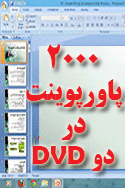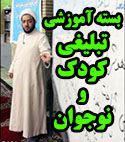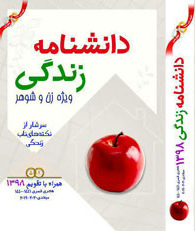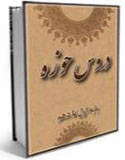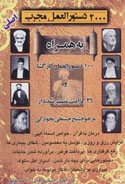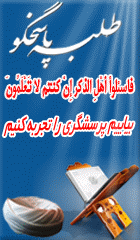Qal'e No-Kharaqan" village in Semnan Province
The mausoleum of a well-known learned scholar of the 4th and 5th lunar Hijri centuries, namely Sheikh Abol-Hassan Kharaqani provides the proof of this village's historical background. The village has been chosen by different Iranian ministries and organizations as a target village for tourism. And now we talk more about "Qal'e No-Kharaqan" village.
Qal'e No-Kharaqan village is a part of Bastam town from the city of Shahrood, and is situated 24 km east of Shahrood. Also known as Kharaqan, the village is on a mountain foot that is 1460 meters above the sea level. Qal'e No-Kharaqan is surrounded by the main top-line of Alborz mountain range from north and is located among the three mountains of Siah-Kooh on East, Zarin-Kooh on North East, and Kooh-Bidar on North West. This village has a fine moderate weather in springs and summers but it is cold in winters. A population of about 3000 people lives in Qal'e No-Kharaqan village; they are Shiite Muslims and speak Farsi with their local accent. Due to the fact that the great mystic, Sheikh Abol-Hassan Kharaqani was born and also lived in this village, it has been attended to by those fond of mysticism from the very past; many other mystics used to gather in the village to meet and confabulate with this sheikh.
Now we speak about the economy of Qal'e No-Kharaqan village. People mostly work in the fields of agriculture, animal husbandry, gardening, masonry, apiculture, and making handicrafts such as weaving rugs and carpets. The flora of the village consists of medicinal herbs such as borage, wild rue, and green meadows all around. Its agricultural products are potato, wheat, barley, corn, beetroot, and garden products like apricot, cherry, and grapes. All farms in this village are irrigated and no dry farming is practiced there. In hot seasons, animal breeders are used to take their cattle to summer resorts that are usually Borun-borun valley, Kooh-Bidar Mountain, and Maryam spring.
Qal'e No-Kharaqan is situated on a not-too-steep slope and has a dense residential texture. Rural houses with gable roofs, and thatch walls, in the heart of green fertile plains, have created beautiful sceneries. These houses are built with regards to natural conditions, and the life style and activities of the inhabitants. The materials used in construction of older houses are often clay, stone, adobe, wood, and brick, while newer ones are made of more resistant materials such as cement, bricks, chalk, and iron beams.
Due to its being located near the forests on the southern skirt of Alborz Mountain range, No-Kharaqan village enjoys many magnificent landscapes. Furthermore, valuable historic monuments have multiplied its attractiveness for tourists and travelers. It’s being green and having fine weather especially in springs and summers have made the village a beauty spot and also a tourist attraction site.
Borun-borun plain, whose name we mentioned earlier in this program, is another natural attraction of No-Kharaqan village with its cover of rich meadows, different colorful flowers, and beautiful plants. These rich meadows and numerous springs have made the plain a summer resort for No-Kharaqan tribes and clans; and as mentioned earlier, some inhabitants of the village move to this plain in order to feed their cattle and stay there for a period of 4 months. Travelers who take a trip to this worth-visiting plain, not only get to know more about tribal life in the region, but also make use of some fresh food products such as high-quality dairy, meat and bread.
On a short distance south of Borun-borun plain, or some 4 km North West of Qal'e No-Kharaqan village, Bidar Mountain and its valley are located. In addition to the lovely nature of its uneven surface, this area shares some of its features with Borun-borun plain.
Of the worth-visiting monuments of Qal'e No-Kharaqan village, mention can be made of a beautiful and historic complex in which the mausoleum of Sheikh Abol-Hassan Kharaqani is situated, remnants of a castle named Kohan-Qal'e dating back to the pre-Islamic period, a historic hill named Koli, an old water storage built in the architectural style of the Qajar period, an old public bath, and some more. The mausoleum of the well-known mystic of the 4th and 5th lunar Hijri centuries, Sheikh Abol-Hassan Kharaqani, is on a hill in the northern part of the village and is surrounded by several green hills that add to its attractiveness. Made of bricks, the building of the mausoleum has been constructed 37 years ago by Iran's National Monuments Association. On the tomb a piece of marble stone is installed on which some poems are carved. Beside the mausoleum there used to be a mosque with a cone-shaped dome decorated with beautiful tiles which dated back to the Ilkhanid era; but today there remains only its Mehrab or altar.
Source: irib.ir
مطالب مشابه با این موضوع:
آپ کے سوالات
- نفس، روح، جان، عقل،اور ذہن و فطرت کے درمیان کیسا رابطہ ہے؟ اس رابطہ کو کیسے بیان کرسکتے ہیں؟ ہم ان میں سے کونسی چیز ہیں؟
- مرجعیت اور تقلید سے کیا مراد ہے؟ کیا تقلید ایک قابل مذمت امر ہے؟
- زیارت وارث کے بارے میں وضاحت کیجئے اورامام حسین (ع) کے وارثِ حضرت آدم (ع) اور حضرت ابراھیم (ع) ہونے کے کیا معنی ہیں؟
- "موعظہ" اور " نصیحت" کے درمیان کیا فرق ہے؟
- سود کے احکام
- کیامرد لذت کے قصد و ارادے سے اپنی ہمسر کے فوٹو اور فلم دیکھ سکتا ہے ؟
- أین دفنت فاطمة الزهراء (ع)؟
- امام علی(ع) کی امامت کے ثبوت میں قرآن مجید کی چند آیات بیان فرمائیے.
- اگر پیامبر(ص)کا وصی پهلے سے معلوم تھا، تو پیغمبر اکرم (ص) نے وصیت کو دعوت قبول کرنے پر کیوں منحصر قرار دیا هے؟
- یه کیسے ممکن هے که ایک لاکھـ صحابیوں نے حدیث غدیر سنی هو اور سقیفه میں کوئی ایک بھی اعتراض نه کرے؟!
- غدیر خم کیوں اس نام سے مشہور ہے؟
- روزہ کا فلسفہ اہلبیت (ع) کی نگاہ میں کیا ھے ؟
- کیا قبرستان میں مسجد تعمیر کی جا سکتی ہے؟
- کیا امام حسین (علیہ السلام) اپنی شہادت سے باخبر تھے ؟
- کیا حضرت علی و فاطمہ زہرا (علیہما السلام) کے گھر پر عمر کے حملہ کی کوئی حقیقت نہیں ہے ؟
- امام زمانه (عج) کس کے ھاتھوں شھيد کئے جائيں گے اور ان کے بعد والا زمانه کتنا طولاني ھوگا؟
- دوستی کے کیا اصول ھیں ؟
- کیا امام حسین (علیہ السلام) کى رقیه نامى کوئى بیٹى تهى؟
- کیا بی بی شهر بانو سے امام حسین (علیہ السلام) کى شادی کا واقعہ صحیح هے؟
- کربلا میں٬ امام حسین(علیہ السلام) کے گهوڑے پر کیاگزری؟
عاشورا شناسی
- زیارت وارث کے بارے میں وضاحت کیجئے اورامام حسین (ع) کے وارثِ حضرت آدم (ع) اور حضرت ابراھیم (ع) ہونے کے کیا معنی ہیں؟
- کیا امام حسین (علیہ السلام) اپنی شہادت سے باخبر تھے ؟
- کیا امام حسین (علیہ السلام) کى رقیه نامى کوئى بیٹى تهى؟
- کربلا میں٬ امام حسین(علیہ السلام) کے گهوڑے پر کیاگزری؟
- امام حسین (علیہ السلام ) کے بدن مطهر کو کس نے دفن کیا؟
- امام حسین (علیہ السلام) کو کیوں ثارالله کهتے هیں؟
- اولیائے الٰہی كیلئے عزاداری كا فلسفہ كیا ہے؟
- کیا زیارت عاشورا کا لعن والا حصہ اس کا جزو ہے یا یہ حصہ بعد میں اضافہ کیا گیا ہے؟
غدیر شناسی
- امام علی(ع) کی امامت کے ثبوت میں قرآن مجید کی چند آیات بیان فرمائیے.
- اگر پیامبر(ص)کا وصی پهلے سے معلوم تھا، تو پیغمبر اکرم (ص) نے وصیت کو دعوت قبول کرنے پر کیوں منحصر قرار دیا هے؟
- یه کیسے ممکن هے که ایک لاکھـ صحابیوں نے حدیث غدیر سنی هو اور سقیفه میں کوئی ایک بھی اعتراض نه کرے؟!
- غدیر خم کیوں اس نام سے مشہور ہے؟
بیشترین بازدیدها
- ہم موت سے کیوں ڈرتے ہیں؟ (9639)
- کیا زیارت عاشورا کا لعن والا حصہ اس کا جزو ہے یا یہ حصہ بعد میں اضافہ کیا گیا ہے؟ (7059)
- او خواهد آمد (7020)
- کیا حضرت علی و فاطمہ زہرا (علیہما السلام) کے گھر پر عمر کے حملہ کی کوئی حقیقت نہیں ہے ؟ (6638)
- امام حسین (علیہ السلام) کو کیوں ثارالله کهتے هیں؟ (6269)
- رمضان کی لغوی اور اصطلاحی معنی کیا ھے ؟ (5817)
- امام حسین (علیہ السلام ) کے بدن مطهر کو کس نے دفن کیا؟ (5773)
- اولیائے الٰہی كیلئے عزاداری كا فلسفہ كیا ہے؟ (5723)
- کیا امام حسین (علیہ السلام) کى رقیه نامى کوئى بیٹى تهى؟ (5572)
- کربلا میں٬ امام حسین(علیہ السلام) کے گهوڑے پر کیاگزری؟ (5387)
- کیا امام حسین (علیہ السلام) اپنی شہادت سے باخبر تھے ؟ (5302)
- امام زمانه (عج) کس کے ھاتھوں شھيد کئے جائيں گے اور ان کے بعد والا زمانه کتنا طولاني ھوگا؟ (5144)
- اسلام میں عورت کی کیا اہمیت ھے ؟ (5037)
آخرین ارسال سایت
- نفس، روح، جان، عقل،اور ذہن و فطرت کے درمیان کیسا رابطہ ہے؟ اس رابطہ کو کیسے بیان کرسکتے ہیں؟ ہم ان میں سے کونسی چیز ہیں؟ (1820) بازدید
- رزق کے بارے میں کونسی روایت موجود ہے؟ (1750) بازدید
- امام سجاد علیہ السلام کی طاغوت کے خلاف اٹھنے والي تحريکوں کي حمايت (1736) بازدید
- مرجعیت اور تقلید سے کیا مراد ہے؟ کیا تقلید ایک قابل مذمت امر ہے؟ (3259) بازدید
- زیارت وارث کے بارے میں وضاحت کیجئے اورامام حسین (ع) کے وارثِ حضرت آدم (ع) اور حضرت ابراھیم (ع) ہونے کے کیا معنی ہیں؟ (1848) بازدید
- "موعظہ" اور " نصیحت" کے درمیان کیا فرق ہے؟ (2168) بازدید
- سود کے احکام (3741) بازدید
- کیامرد لذت کے قصد و ارادے سے اپنی ہمسر کے فوٹو اور فلم دیکھ سکتا ہے ؟ (3831) بازدید
- أین دفنت فاطمة الزهراء (ع)؟ (2059) بازدید
- امام علی(ع) کی امامت کے ثبوت میں قرآن مجید کی چند آیات بیان فرمائیے. (3464) بازدید
- اگر پیامبر(ص)کا وصی پهلے سے معلوم تھا، تو پیغمبر اکرم (ص) نے وصیت کو دعوت قبول کرنے پر کیوں منحصر قرار دیا هے؟ (3155) بازدید











